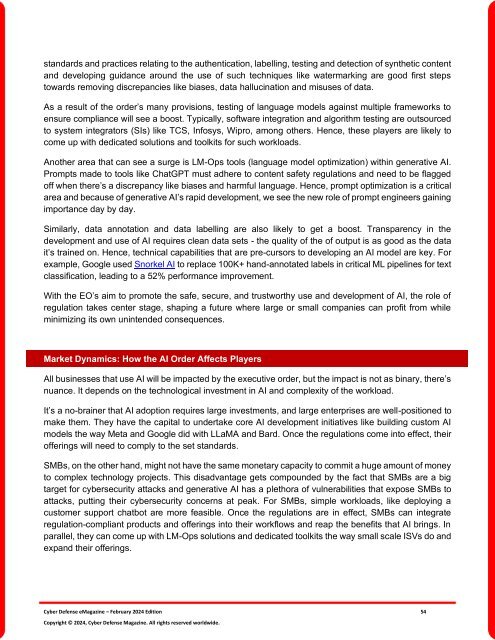The Cyber Defense eMagazine February Edition for 2024
Cyber Defense eMagazine February Edition for 2024 #CDM #CYBERDEFENSEMAG @CyberDefenseMag by @Miliefsky a world-renowned cyber security expert and the Publisher of Cyber Defense Magazine as part of the Cyber Defense Media Group as well as Yan Ross, Editor-in-Chief and many more writers, partners and supporters who make this an awesome publication! 155 page February Edition fully packed with some of our best content. Thank you all and to our readers! OSINT ROCKS! #CDM #CDMG #OSINT #CYBERSECURITY #INFOSEC #BEST #PRACTICES #TIPS #TECHNIQUES
Cyber Defense eMagazine February Edition for 2024 #CDM #CYBERDEFENSEMAG @CyberDefenseMag by @Miliefsky a world-renowned cyber security expert and the Publisher of Cyber Defense Magazine as part of the Cyber Defense Media Group as well as Yan Ross, Editor-in-Chief and many more writers, partners and supporters who make this an awesome publication! 155 page February Edition fully packed with some of our best content. Thank you all and to our readers! OSINT ROCKS! #CDM #CDMG #OSINT #CYBERSECURITY #INFOSEC #BEST #PRACTICES #TIPS #TECHNIQUES
You also want an ePaper? Increase the reach of your titles
YUMPU automatically turns print PDFs into web optimized ePapers that Google loves.
standards and practices relating to the authentication, labelling, testing and detection of synthetic content<br />
and developing guidance around the use of such techniques like watermarking are good first steps<br />
towards removing discrepancies like biases, data hallucination and misuses of data.<br />
As a result of the order’s many provisions, testing of language models against multiple frameworks to<br />
ensure compliance will see a boost. Typically, software integration and algorithm testing are outsourced<br />
to system integrators (SIs) like TCS, Infosys, Wipro, among others. Hence, these players are likely to<br />
come up with dedicated solutions and toolkits <strong>for</strong> such workloads.<br />
Another area that can see a surge is LM-Ops tools (language model optimization) within generative AI.<br />
Prompts made to tools like ChatGPT must adhere to content safety regulations and need to be flagged<br />
off when there’s a discrepancy like biases and harmful language. Hence, prompt optimization is a critical<br />
area and because of generative AI’s rapid development, we see the new role of prompt engineers gaining<br />
importance day by day.<br />
Similarly, data annotation and data labelling are also likely to get a boost. Transparency in the<br />
development and use of AI requires clean data sets - the quality of the of output is as good as the data<br />
it’s trained on. Hence, technical capabilities that are pre-cursors to developing an AI model are key. For<br />
example, Google used Snorkel AI to replace 100K+ hand-annotated labels in critical ML pipelines <strong>for</strong> text<br />
classification, leading to a 52% per<strong>for</strong>mance improvement.<br />
With the EO’s aim to promote the safe, secure, and trustworthy use and development of AI, the role of<br />
regulation takes center stage, shaping a future where large or small companies can profit from while<br />
minimizing its own unintended consequences.<br />
Market Dynamics: How the AI Order Affects Players<br />
All businesses that use AI will be impacted by the executive order, but the impact is not as binary, there’s<br />
nuance. It depends on the technological investment in AI and complexity of the workload.<br />
It’s a no-brainer that AI adoption requires large investments, and large enterprises are well-positioned to<br />
make them. <strong>The</strong>y have the capital to undertake core AI development initiatives like building custom AI<br />
models the way Meta and Google did with LLaMA and Bard. Once the regulations come into effect, their<br />
offerings will need to comply to the set standards.<br />
SMBs, on the other hand, might not have the same monetary capacity to commit a huge amount of money<br />
to complex technology projects. This disadvantage gets compounded by the fact that SMBs are a big<br />
target <strong>for</strong> cybersecurity attacks and generative AI has a plethora of vulnerabilities that expose SMBs to<br />
attacks, putting their cybersecurity concerns at peak. For SMBs, simple workloads, like deploying a<br />
customer support chatbot are more feasible. Once the regulations are in effect, SMBs can integrate<br />
regulation-compliant products and offerings into their workflows and reap the benefits that AI brings. In<br />
parallel, they can come up with LM-Ops solutions and dedicated toolkits the way small scale ISVs do and<br />
expand their offerings.<br />
<strong>Cyber</strong> <strong>Defense</strong> <strong>eMagazine</strong> – <strong>February</strong> <strong>2024</strong> <strong>Edition</strong> 54<br />
Copyright © <strong>2024</strong>, <strong>Cyber</strong> <strong>Defense</strong> Magazine. All rights reserved worldwide.

















